Château d'Agassac
Château D'Agassac is a Haut-Médoc wine estate located on the village of Ludon-Médoc in the Médoc, only 15 minutes from the city of Bordeaux in France. Its red wine is a famous Cru Bourgeois ranked "Cru Bourgeois Exceptionnel" in the historic Bordeaux Wine Official Classification of 1932. The property is also a leader in enotourism.
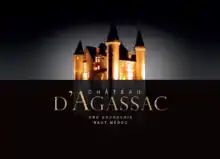
History
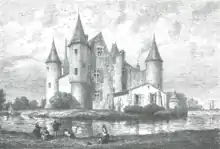
According to a local tradition, a Latin inscription found in the underground galleries of the Château dates its construction back to the 13th century. But the first of its known lords was Guillaume-Raymond d'Agassac in 1172, Lord of Blanquefort.
- Since 1238, the Gaillard de Gassac Family is owner of the seigniory of Agassac which extends more than 800 hectares. Its lord is vassal of king of England, Edward I of England, called in London in 1299 and took part in the defense of Borough in 1296.
- In 1357, the seigneury was sold to the lordship of Albret and some members of the family came to Agassac as Arnaud Amadieu I, Charles II of Albret or Jean II of Albret.
- From 1580 to 1841 (during three centuries (16th - 17th - 18th centuries)), the property belongs to Pommiers Family. One of its member was President of Guyenne Parliament house.
In 1792 the first vines was planted and the winery created.
- In 1841, the estate was purchased by Marcel Richier, one of the first big agricultural engineer in France. During the 19th century, wines of the property was sold abroad under Château Ludon and Château Pomiès.
- In 1961 two members of Capbern-Gasqueton Family, Philippe Capbern-Gasqueton and Henry Capbern-Gasqueton, purchased Château D'Agassac. At the same time, Philippe Capbern-Gasqueton is the owner of Château Calon-Ségur one of fourteen Troisièmes Crus Classés (Third Growths) in the Bordeaux Wine Official Classification of 1855 in Saint-Estèphe and Château du Tertre one of eighteen Cinquièmes Crus (Fifth Growths) in the Bordeaux Wine Official Classification of 1855 in Saint-Estèphe.
- In 1996, the winery is purchased by the international insurance group Groupama. A very important renovation work was engaged to do of the estate one of the most beautiful properties of the Haut-Médoc.
Geology and Terroir
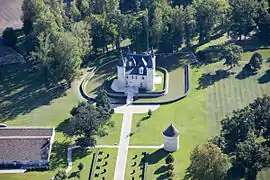
The terroir of the estate is situated in the southern part of Ludon-Médoc between two gravely outcrops and an area of sandy gravel.
- The two gravely outcrops : Grand Terroir of the estate
The first consists of extremely fine gravel from the river and very characteristic of the commune of Ludon-Médoc. This gravely structure which can reach depths of up to 3 meters lends itself to ideal draining of water and results in a considerably early ripening of the grapes in this part of the vineyard, producing extremely refined and elegant wines. The second outcrop is made up of large Gunz gravel which forms a carpet much deeper than the first outcrop (+6m). However, given the greater proportion of clay, it lends itself to full-bodied wines with a more firm backbone.
- The sandy gravel soils
It results in supple, palatable wines with a harmonious presence of tannins and devoid of all sharpness.
Viticulture
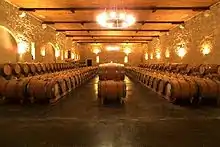
- Area : 43 hectares
- Grape varieties : Merlot 50% / Cabernet Sauvignon 47% / Cabernet Franc 3%
- Average age of the vineyard : 25 years
- Planting density : 6 700 shoots per hectare
- Crop thinning, bud and leaf removal
- Crop management : "Terra Vitis" and "Integrated Agriculture" certifications
Harvest/Winemaking
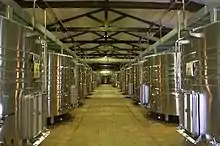
- Harvest : The grapes are first sorted in the vineyard completed by a second sorting in the cellar
- Winemaking : 23 temperature-controlled stainless steel vats with maceration (wine) for 3 to 4 weeks
- Ageing : 12 to 15 months, 60% in new barrels and 40% in vats to keep fruity aromas
- Coopers : Berthomieu, Cadus, Miquel, Doreau, Baron
- Bottling in the estate : Fining with egg whites and light filtering
Wines
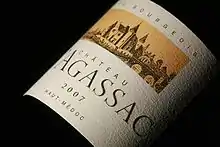
D'Agassac is today one of the wines of the Haut-Médoc with the best scores and the most awards : 2000 Vintage year : "One of the 100 best wines of the World" by the Wine Spectator sélection in United States (April 2003). The winery produces 5 various wines :
- Château D'Agassac : Grand vin of the vineyard, Cru Bourgeois since 1932.
- Château Pomiès-Agassac : second wine of the estate.
- Château Pomiès-Agassac : the other second wine of the property. It is a selection of the finest batches used to produce the Château Pomiès-Agassac "classic"
- L'Agassant D'Agassac : the second label of Château D'Agassac since 2006 made with 90% Merlot grapes.
- Précision D'Agassac : a Vintage Cuvée produced only for great years since 2009.
Enotourism
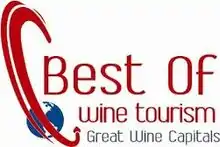
The estate is opening for visiting and wine tasting. Member of the Great Wine Capitals Global Network, Château D'Agassac often win the Best Of Wine Tourism Contest for its quality of reception and infrastructure (2006, 2007, 2009 and 2012). It is possible to rent the estate for seminar, dinner or wedding.
External links
- Château D'Agassac official site (in French and English)
- Guide Féret official site
- Best Of Wine Tourism official site
- Great Wine Capitals Global Network official site
- Terra Vitis certification official site
Bibliography
- Féret, Guide du Vin depuis 1812, sur la façon d'orthographier les appellations d'origine
- Léo Drouyn, La Guienne militaire - Histoire et description des villes fortifiées, forteresses et châteaux [...] pendant la domination anglaise, Tome Second - 1865
- Jacques Gardelles, Les Châteaux du Moyen-Age dans la France du Sud-Ouest - La Gascogne anglaise de 1216 à 1327, 1972
- Henry Ribadieu, Les Châteaux de la Gironde, Deuxième Editions - 1856
- Michel Smaniotto, Le Médoc Féodal - Les grandes seigneuries du XIe au XVe siècle, 1988